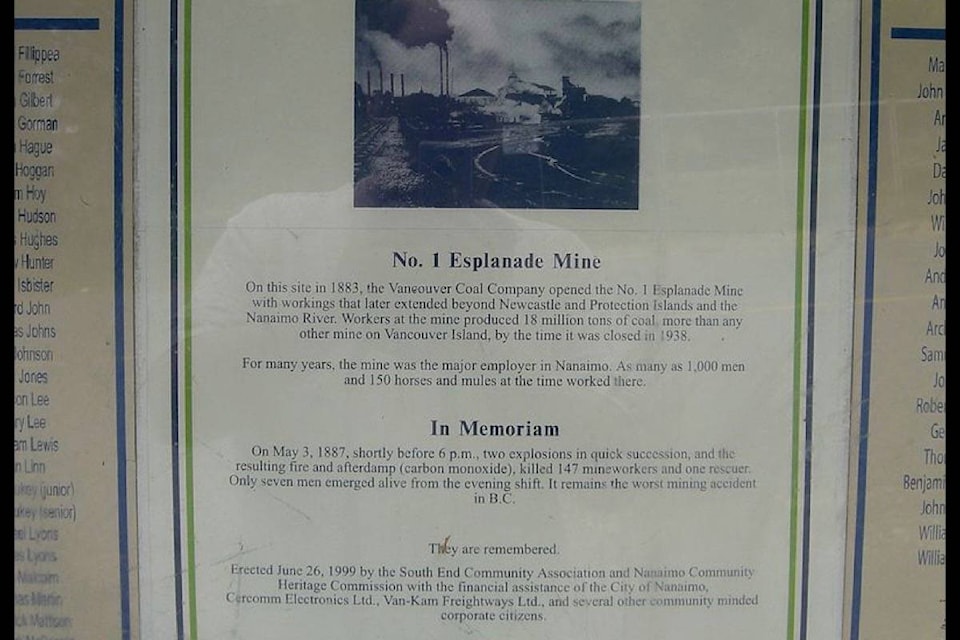“We gather here to fulfill those words that are enshrined here: ‘That their light will always shine.’”—Rev. Jim Webber-Cook.
Last week, I was interviewed on the occasion of the 130th anniversary of the catastrophic explosion in Nanaimo No. 1 Esplanade Mine that killed 147 men of the afternoon shift — not, alas, in every case instantly — in what is Canada’s second worst colliery disaster.
It seems that, should you mention coal mine disasters with high mortality, most people think of the Cape Breton coal mine that has been celebrated in folksong and folklore: Springhill, N.S.
But, without in any way detracting from that tragic event, here in western Canada is where the greatest tragedies occurred. As noted, Nanaimo, on May 3, 1887, is No. 2. The worst of them all happened next door at Hillcrest, Alberta, on the morning of June 19, 1914. No fewer than 189(!) men died in that one.
The Nanaimo press noted that, for the third time since 2015, the flag at City Hall would be flown at half-mast in respect of the devastating disaster, the Hub City’s worst. It’s unfortunate that this act of homage was ever discontinued; for years, the flag at Nanaimo’s historic Bastion marked the anniversary but, somehow, the practice fell by the wayside.
Which, I’m sorry to say, really doesn’t surprise me. The sad fact is that Nanaimo citizens long ago turned their backs on their ‘black’ past, seemingly embarrassed by their hard-labour roots. The harbourfront signboard that today lists the 148 victims (147 miners and one rescuer) of the No. 1 blast, by name and by number in the case of the 53 Chinese miners, had to be paid for and erected by private citizens some years ago. Until then, there was no memorial of any description anywhere within the City of Nanaimo for those 148 victims of the No. 1.
Doesn’t this defy both logic and sentiment? Think of it: in a town of just over 2,000 souls, 148 men suddenly snatched away! There were 41 instant widows, 129 fatherless children. Gone were older brothers, uncles, cousins, friends, former schoolmates, sports chums and co-workers. There wouldn’t have been a single living soul in Nanaimo who didn’t lose a family member, an in-law, a friend or an acquaintance. Was the heartache so great that collective amnesia was self-imposed until the passing years and changing demographics did the rest to bury the horror of it all?
As to the cause of the fatal blast in No. 1 Mine, an inquiry speculated that an improperly fired charge triggered an explosion of gas and coal dust. The reality was that, in spite of every and all precautions, it was virtually inevitable that gas and coal dust would be ignited when miners used open-flame lanterns. A sad fact which accounts for some of the other Island colliery disasters over the industry’s 90-year history.
What excuse, then, for New Glasgow, Nova Scotia’s Westray Mine? This one dates back only 25 years, to May 9, 1992. Again, it was a lethal mix of methane gas and coal dust that ignited. Making it even sadder, it occurred in the final hours of a four-day work shift. The huge fireball that flashed through the mine levels incinerated 26 miners, 11 of whose bodies have never been recovered.
Hadn’t the industry learned anything about safety procedure? This mine had opened just a year before; surely it had all of the latest and best safety gear and practised all the precautions learned over more than a century of coal mining in the province?
Apparently not, as it turned out; even the miners who were killed had feared that each shift might be their last because management balked at the expense of adequately dealing with excessive coal dust. According to the Canadian Press report of the ceremony marking the Westray disaster’s 25th anniversary, a Nova Scotia supreme court justice concluded in 1997 that the disaster resulted from “incompetence, mismanagement, bureaucratic bungling, deceit, ruthlessness and cynical indifference”.
It would be impossible to arrive at a more damning verdict than that. Although two of the mining company’s top executives were charged with manslaughter and criminal negligence, the Crown concluded convictions were unlikely and relented.
The deaths of those 26 Westray miners echoed those of almost 1,000 Vancouver Island miners who died on the job, often in circumstances just as sinister, just as inexcusable.
If there’s a consolation prize in the Westray affair, it’s that it has prompted new and tougher safety rules in the workplace.
Here in the Cowichan Valley, Workers’ Memorial Day, April 28, was observed five days before the 130th anniversary of the No. 1 Mine blast, and 11 days before 200 people gathered to pay homage at Westray Miners Memorial Park in New Glasgow.
But coal mine disasters are just ancient history, right? And we all know how boring that is.
